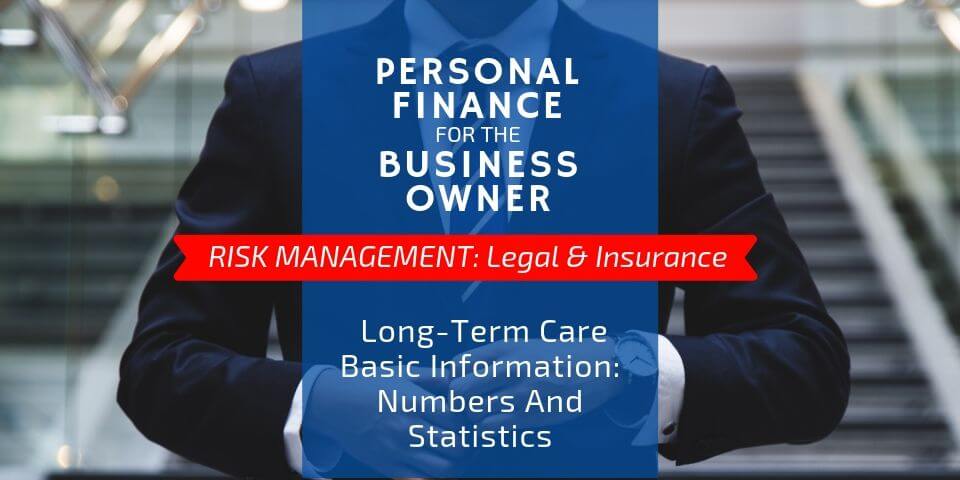
Business Overhead Disability Insurance: What To Know Before You Buy
September 3, 2019
Long-Term Care Part II – Insurance Options For Small-Business Owners
September 12, 2019Long-Term Care Basics Part I – The Numbers Behind the Need

When I was about sixteen years old, my grandmother came to live with us. We moved the “boys’ room” upstairs above the garage, and our grandma moved into what had been our bedroom. As a bright, young teenage boy, I was very aware of the situation that was taking place in our home, and it wasn’t long before I saw the toll that dementia takes on a person. Likewise, I quickly learned what a daunting task it is to care for someone who is suffering from dementia. I watched as my mother endured the stress and exhaustion of providing every need and taking every precaution to ensure Grandma’s safety and well-being. I’ve got to tell you; it can be overwhelming. As I look back on that time in our lives, I can’t help but think about the value of long-term care. It’s a term we hear pretty frequently, but how many of us really know what it means in practice? Let’s discuss long-term care basics and how they might affect the small-business owner.
Follow along with the Financially Simple podcast:
Podcast Time Index for “Long-Term Care – What Is It And How Do You Plan For It?”:
- 01:18 – Long-Term Care – the Overview
- 01:28 – A Personal Experience
- 03:18 – Long-Term Care for Business Owners
- 05:00 – What is Long-Term Care?
- 07:45 – How Big of a Problem is it?
- 11:48 – Stats on the Cost of Long-Term Care
- 15:10 – What if Your Employees are Affected?
- 16:02 – Stats on Claims Paid for Long-Term Care
- 18:28 – Wrap Up
Long-Term Care Defined
Regardless of how unpleasant the subject may be, the cold hard truth is that most of us will need some form of long-term care in our lifetimes. In fact, 70% of people over the age of sixty-five will require long-term care. So what exactly is entailed by the term? Well simply stated, long-term care is a set of services provided to help people live as independently and safely as possible when they can no longer perform everyday activities on their own.
One aspect of these services is personal care. Personal care assists you or your loved ones with the activities of daily living. If that sounds a bit like an insurance term, that’s because it is. Activities of daily living are your basic tasks, things like bathing, grooming, getting dressed, using the bathroom, and feeding yourself. These are things that we tend to take for granted when we are young and healthy but can become quite challenging once our youth and physical or mental health have turned. In my grandmother’s case, she was physically able to accomplish many of these common tasks but as dementia took hold, she wasn’t always sure why she needed to do them.
How Great Is The Need for Long-Term Care?
Over the next eighteen years, 80-million Americans will turn fifty years old or older. As I mentioned before, 70% of people over the age of sixty-five will require long-term care. By this number, we will see roughly 60-million more Americans needing long-term assistance by 2050. There are currently 16-million people in the U.S. providing unpaid care for their loved ones, a number that is also expected to drastically increase over the next eighteen years.
It is estimated that nearly 18-billion unpaid hours are placed into helping people care for their parents, equating to around $200-billion in costs. The impact of long-term care is certainly a costly one but it is also a personal one. One-third of all caretakers are the daughters of the person being cared for. Around 25% of the time, the caretaker is providing care for their elder while also raising a child under the age of eighteen. As one could imagine, caring for a loved one isn’t an easy task to take on. It is a high-cost, high-stress, and emotionally taxing endeavor.
Why Is Long-Term Care Needed?
Since 2000, death from heart disease has decreased by 9%. In that same timespan, Alzheimer’s deaths have increased by 145% and are expected to continue rising. Alzheimer’s kills more people every year than prostate and breast cancer combined. It is projected that the disease will cost the U.S. economy $300-billion this year and estimates have that sum increasing to 1-trillion dollars by 2050. 60-million people are currently suffering from Alzheimer’s with 1-in-10 of them being over the age of sixty.
I bring all of this up to say that, like my grandmother, many people are affected by Alzheimer’s and dementia. There are a vast number of diseases and handicaps that any one of us could be stricken with at any given moment. Life turns on a dime and it doesn’t always go the way you think it’s going to.
RELATED CONTENT: Life Insurance Considerations for Business Owners
GenWorth Life Insurance reports that since 1974, they have paid over 162,000 long-term care claims. Through the end of 2011, benefits they paid out totaled $7.7-billion with their most expensive claim being reported at $1.2-million. Each day, they paid $4.3-million in long-term claims. Each day! Out of all of the long-term claims paid by GenWorth, 50% were paid to people suffering from Alzheimer’s or dementia. If you’re reading this and saying, “I don’t need to worry about this until I’m nearing retirement.” GenWorth’s youngest long-term care claimant was just twenty-seven years old.
Long-term care is needed because at some point, there’s a good chance that you won’t be able to care for yourself in the ways that you are currently able to. It’s needed because you don’t know how long you will remain unable to do so. In my grandma’s case, she spent fifteen years in an assisted living facility. GenWorth Life Insurance paid a benefit to a claimant that continued for 18.7 years.
The Cost of Long-Term Care
There are many ways that the total cost of long-term care can be defined. Already, I’ve mentioned a few of the financial, emotional, and time costs but what about how it impacts your business or your employees? What happens if one of your key employees suddenly has to step away to care for their mother or father? The annual cost for lost productivity for companies because of long-term care responsibilities of their employees is roughly $25-billion.
I hope that this has given you something to think about. The issue of long-term care is a complicated one. That’s why I will be continuing it in my next installment which deals with picking the right insurance for long-term care. In the meantime, assess the risk of long-term care and its impact on your business. Are you prepared for any inevitability? With the right knowledge and the proper preparation, you don’t need to worry. Live life simply!



